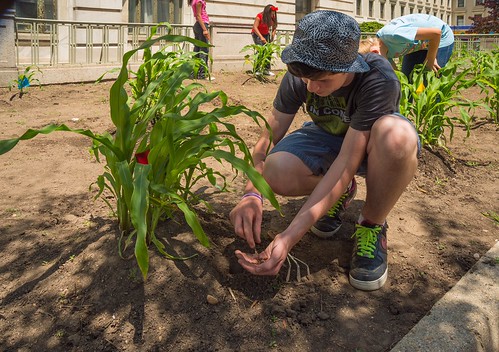
Rory Hagerty, a seventh grade student from Alice Deal Middle School, plants beans in USDA’s Three Sisters Garden, part of the People’s Garden on the National Mall in Washington. USDA’s Faith Based and Neighborhood Partnerships office sponsored the event. USDA photo by Bob Nichols.
USDA celebrates National Native American Heritage Month in November with a blog series focused on USDA’s support of Tribal Nations and highlighting a number of our efforts throughout Indian Country and Alaska. Follow along on the USDA blog.
For centuries, Native Americans have cultivated the soil and produced corn, beans and squash. Stories, ceremonies, songs and cultural traditions surround the annual planting, growing and harvest of gardens. Life lessons were learned throughout the gardening season. Stories of the Three Sisters refer to a tradition of interplanting corn, beans and squash in the same mound. It is a sophisticated, sustainable planting system that provided long term soil fertility and a healthy diet to generations of Native Americans.
Corn is the oldest sister. She stands tall in the center and provides strength and protection to her sisters below. She is not a lone plant, as she grows with a handful of corn sisters. Beans are the second sister. She surrounds sister corn and reaches to the sun, climbing up the corn stalks. Her role is to keep the soil fertile by converting the sun’s energy into nitrogen filled nodules that grow on its roots. As she grows, she shares and uses the stored nitrogen as food. Squash is the third sister. Her vines trail over the mound, her leaves protect the sisters from weeds and shade the soil from the sun, and her beautiful blooms invite the bees and pollinate the Sisters while keeping the ground cool and moist. Her prickly stems help to deter pests and rodents from eating the nutritious produce.
Whether you’re a beginning farmer, or a veteran producer, there’s an advantage in working together – much like the three sisters – to cooperate and benefit each other.
USDA Rural Development has resources to help producers succeed with developing a value-added product from what they grow and harvest; improving the energy efficiency of their operations to reduce input costs and bolster the bottom line on the ledger book; forming a cooperative for product marketing; or even working together to establish a small commercial kitchen to process and prepare the harvest into something marketable to feed customers whether locally or globally. There are even special funds set aside to support Native American projects – and Tribal entities are encouraged to apply.
Your nearest USDA Rural Development office has specialists on hand that can help determine how we can help support emerging rural small businesses and producers – just another form of cooperation that makes everyone better in the long run.
No comments:
Post a Comment
Note: Only a member of this blog may post a comment.